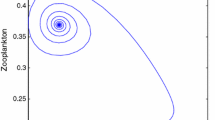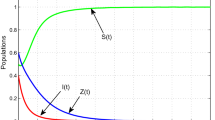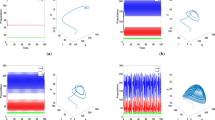Abstract
In this paper, a toxin producing phytoplankton–zooplankton system with the delay is investigated. Firstly, the nonnegativity and boundedness of solutions are given. Then the local and global asymptotic stabilities of the boundary equilibrium are investigated, and the existence of local Hopf bifurcations is established as the delay crosses a threshold value at the positive equilibrium. Furthermore, there exists at least one positive periodic solution as the delay varies in some regions by using the global Hopf bifurcation result of Wu for functional differential equations. In addition, the impacts of the toxic substances are also investigated. At last, an explicit algorithm is derived for the stability and direction of the bifurcating periodic solution by using center manifold theory and normal form method.




Similar content being viewed by others
References
Duinker, J., Wefer, G.: Das \(CO_2\)-problem und die rolle des ozeans. Naturwissenschaften 81, 237–242 (1994)
Smayda, T.: What is a bloom? A commentary. Limnol. Oceonogr. 42, 1132–1336 (1997)
Anderson D.: Toxic algae blooms and red tides: a global perspective. Red tides: Environmental Science and Toxicology, 11–16 (1989)
Hallegraeff, G.: A review of harmful algae blooms and the apparent global increase. Phycologia 15, 79–99 (1993)
Mukhopadhyay, B., Bhattacharyya, R.: Role of gestation delay in a planktonCfish model under stochastic fluctuations. Math. Biosci. 215, 26–34 (2008)
Stoermer, E., Smol, J.: The Diatoms. Cambridge University Press, Cambridge (1999)
Rehim, M., Imran, M.: Dynamical analysis of a delay model of phytoplankton–zooplankton interaction. Appl. Math. Model. 36, 638–647 (2012)
Wang, Y., Jiang, W., Wang, H.: stability and global Hopf bifurcation in toxic phytoplankton–zooplankton model with delay and seletive harvesting. Nonlinear Dyn. 73, 881–896 (2013)
Levin, S., Segel, L.: Hypothesis for the origin plankton patchiness. Nature 259, 659–659 (1976)
Uye, S.: Impact of copepod grazing on the red tide flagellate chattonella antiqua. Mar. Biol. 92, 35–43 (1986)
Upadhyay, R., Chattopadhyay, J.: Chaos to order: role of toxin producing phytoplankton in aquatic systems. Nonlinear Anal. Model. Control 10, 383–396 (2005)
Jang, S., Baglama, J., Rick, J.: Nutrient-phytoplankton–zooplankton models with a toxin. Math. Comput. Model. 43, 105–118 (2006)
Saha, T., Bandyopadhyay, M.: Dynamical analysis of toxin producing phytoplankton–zooplankton interactions. Nonlinear Anal. Real World Appl. 10, 314–332 (2009)
Buskey, E., Hyatt, C.: Effects of the Texas (USA)brown tide alga on planktonic grazers. Mar. Ecol. Prog. Ser. 126, 285–292 (1995)
Hansen, F.: Trophic interactions between zooplankton and phaeocystis cf. globosa. Helgol. Meeresunters. 49, 283–293 (1995)
Chattopadhayay, J., Sarkar, R., Mandal, S.: Toxcin-producing plankton may act as a biological control for planktonic blooms-field study and mathematical modeling. J. Theor. Biol. 215, 333–344 (2002)
Dhar, J., Sharma, A., Tegar, S.: The role of delay in digestion of plankton by fish population: a fishery model. J. Nonlinear Sci. Appl. 1, 13–19 (2008)
Chattopadhyay, J., Sarkar, R., El Abdllaoui, A.: A delay differential equation model on harmful algal blooms in the presence of toxic substances. IMA J. Math. Appl. Med. Biol. 19, 137–161 (2002)
Tang, Y., Zhou, L.: Great time delay in a system with material cycling and delayed biomass growth. IMA J. Appl. Math. 70, 191–200 (2005)
Tang, Y., Zhou, L.: Stability switch and Hopf bifurcation for a diffusive prey-predator system with delay. J. Math. Anal. Appl. 334, 1290–1307 (2007)
Saha, T., Bandyopadhyay, M.: Dynamical analysis of toxin producing phytoplankton-zooplankton interactions. Nonlinear Anal. Real World Appl. 10, 314–332 (2009)
Hassard, B., Kazarinoff, N., Wan, Y.: Theory and Application of Hopf Bifurcation. Cambridge University Press, Cambridge (1981)
Hale, J., Lunel, S.: Introduction to Functional Differential Equations. Springer, New York (1993)
Lakshmikantham, V., Leela, S.: Differential and Integral Inequalities (Theory and Application): Ordinary Differential Equations. I. Academic Press, New York (1969)
Beretta, E., Kuang, Y.: Geometric, stability switch criteria in delay differential systems with delay dependent parameters. SIAM J. Math. Anal 33, 1144–1165 (2002)
Faria, T., Magalhaes, L.: Normal form for retarded functional differential equations and applications to Takens-Bogdanov singularity. J. Differ. Equ. 122, 201–224 (1995)
Qu, Y., Wei, J., Ruan, S.: Stability and bifurcation analysis in hematopoietic stem cell dynamics with multiple delays. Physica D 239, 2011–2024 (2010)
Wu, J.: Symmetric functional differential equations and neural networks with memory. Trans. Am. Math. Soc. 35, 4799–4838 (1998)
Acknowledgments
The authors are grateful to anonymous referee for careful reading of the manuscript and making useful comments on the revision of the paper, and also thank Prof. Yasuhiro Takeuchi of Shizuoka University for very helpful suggestions and comments, which helped improve the presentation of the paper. The research was supported by National Natural Science Foundation of China (No. 11471034), Scientific Research Fund of North China Institute of Astronautic Engineering (No. YY-2013-01) and the innovation team project of North China Institute of Astronautic Engineering (No. XJTD-201417).
Author information
Authors and Affiliations
Corresponding author
Appendix: Property of Hopf bifurcation
Appendix: Property of Hopf bifurcation
In this section, based on numerical evaluation of Hopf bifurcations [22], it gives the computing process of the direction of Hopf bifurcations and stability of the bifurcating periodic solutions from \(E^*\) under the conditions of Theorem 3.7 (ii). Let \(\omega ^0=\omega (\tau ^0)\), \(\tau =\tau ^0+\mu \), then \(\mu =0\) is a Hopf bifurcation value of the system (1.5). Rewrite (3.10) as
where
and for \(\varphi \in C\), define
where \(C=C([-\tau ,0],R_+^2)\) with the norm \(|\varphi |=\sup _{-\tau \le \theta \le 0}|\varphi (\theta )|\) is the phase space. Clearly, \(L_\mu \) is a linear continuous operator from \(C\) to \(R_+^2\). By the Riesz representation theorem, there exists a matrix whose components are bounded variation functions \(\eta (\theta ,\mu )\) in \(\theta \in [-\tau ,0]\) such that
where \(\varphi \in C.\) In fact, it may choose
where
For \(\varphi \in C^1=C([0,\tau ],(R_+^2)^{*})\) , define
and
where
is the nonlinear term of the right side of the system (6.1).
Let \(u=(x,y)^T ,\) then the system (6.1) can be rewritten as
For \(\psi \in C^1\) , define
and a bilinear form
where \(\eta (\theta )=\eta (\theta ,\tau ^0).\) Then \(A^*\) and \(A\) are adjoint operators. In addition, from Sect. 2, we know that \(\pm i\omega ^0\) are the eigenvalues of \(A(\tau ^0)\). Thus they are also the eigenvalues of \(A^*\).
By direct computation, it can obtain that \( q(\theta )=\Big (1,\,q_2\Big )e^{i\omega ^0\theta } \) is the eigenvector of \(A(0)\) corresponding to \(i\omega ^0 \); and \( q^*(s)=\bar{D}\Big (1,\,q_2^*\Big )^Te^{i\omega ^0 s} \)
is the eigenvector \( A^* \) corresponding to \(-i\omega ^0\), where
Moreover,
where
Using the same notations as in [22], it can obtain
where
and
and
with
and
Then \(g_{21}\) can be expressed by the parameters. Based on the above analysis, we can see that each \(g_{ij}\) can be determined by the parameters. Thus it can compute the following quantities:
Hence it has the following theorem.
Theorem 6.1
\(\mu _2\) determines the directions of the Hopf bifurcation: if \(\mu _2>0(<0)\), the Hopf bifurcation is supercritical (subcritical); \(\beta _2\) determines the stability of the bifurcation periodic solutions: the bifurcation periodic solutions are orbitally stable (unstable) if \(\beta _2<0(>0)\); and \(T_2\) determines the period of the bifurcating periodic solutions: the period increase (decrease) if \(T_2>0(<0)\).
About this article
Cite this article
Jiang, Z., Ma, W. & Li, D. Dynamical behavior of a delay differential equation system on toxin producing phytoplankton and zooplankton interaction. Japan J. Indust. Appl. Math. 31, 583–609 (2014). https://doi.org/10.1007/s13160-014-0152-6
Received:
Revised:
Published:
Issue Date:
DOI: https://doi.org/10.1007/s13160-014-0152-6




